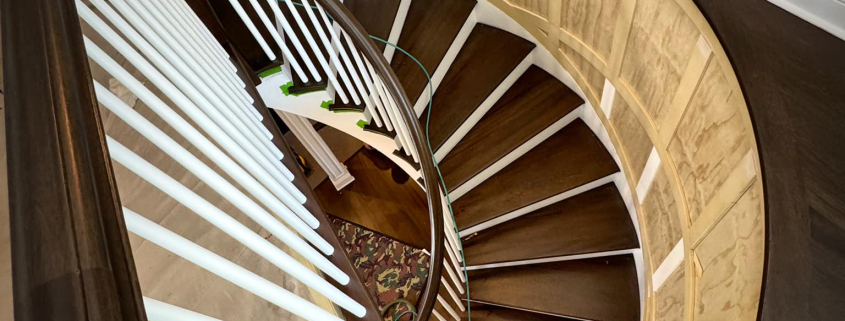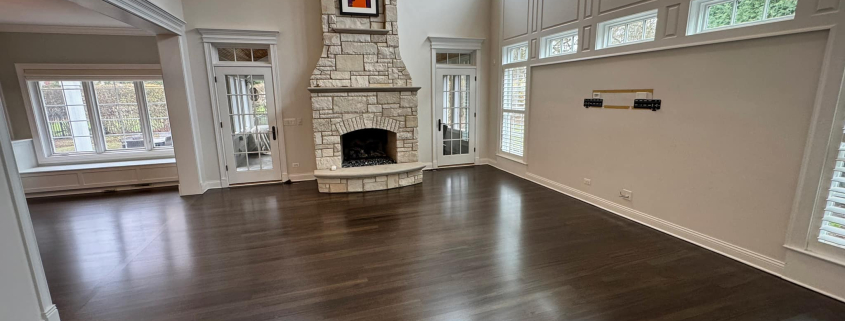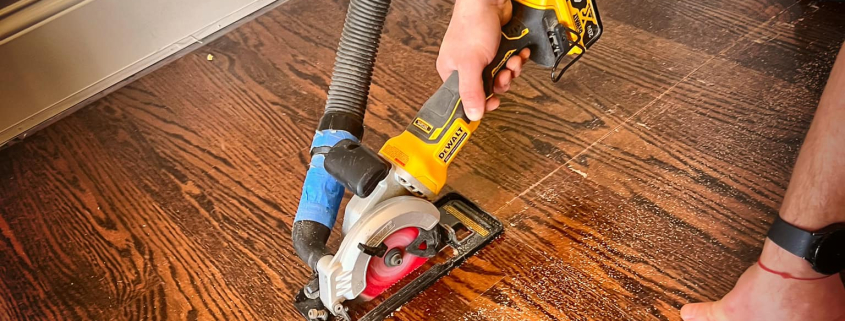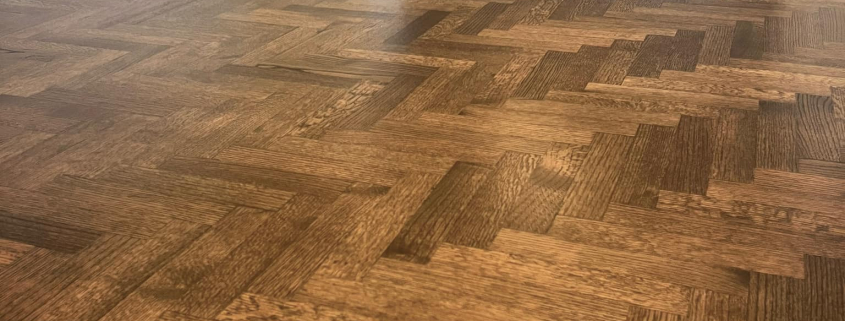When your hardwood floors start to look worn, scratched, or dated, you might find yourself asking a big question: Should I refinish or replace my floors?
At first glance, a brand-new floor might sound appealing—but refinishing your existing hardwood could offer the same visual transformation at a fraction of the cost. Let’s break down the key differences between the two options to help you make the smartest decision for your home and budget.
1. The Cost Factor
Refinishing:
Refinishing hardwood floors is significantly more cost-effective. Depending on the condition of your floors and the size of your space, refinishing typically costs 50–70% less than full replacement. You’ll avoid material costs and reduce labor fees, all while getting that “brand new” look.
Replacing:
Replacing floors includes not only new hardwood materials but also the removal of old flooring, subfloor repairs (if needed), installation, staining, and finishing. It adds up quickly and often comes with more unexpected costs.
👉 Winner: Refinishing — hands down, it’s the budget-friendly choice.
2. Time & Disruption
Refinishing:
Most refinishing jobs are completed in 3–5 days, depending on the size and whether you opt for custom staining. Plus, modern dustless sanding options keep your home cleaner and safer throughout the process.
Replacing:
Full replacement can take a week or more, especially if subfloor work is needed or if you’re using special-order wood. It’s a bigger disruption to your daily life.
👉 Winner: Refinishing — less mess, less stress, and faster turnaround.
3. Environmental Impact
Refinishing:
Preserving your existing floors is a sustainable choice. You’re minimizing waste and making the most of the materials already in your home.
Replacing:
Even responsibly sourced hardwood still requires harvesting, shipping, and installation. Plus, your old flooring may end up in a landfill.
👉 Winner: Refinishing — it’s the greener solution.
4. Visual Impact
Many homeowners are surprised by how dramatic the transformation can be after refinishing. You can:
-
Change the color and tone of your floors
-
Remove deep scratches and dull finishes
-
Highlight the natural grain and character of your wood
In most cases, unless your flooring is severely damaged or too thin to sand, refinishing can give you the exact look you want—without a full replacement.
So, When Should You Replace Instead?
While refinishing is the ideal solution for many, here are a few cases when replacing may be necessary:
-
Your floors are warped, water-damaged, or structurally compromised.
-
The hardwood has been refinished too many times and is too thin.
-
You want to switch materials entirely, like going from oak to walnut or hardwood to luxury vinyl.
Let’s Talk About Your Floors
At Tom & Peter Flooring, we’ve helped homeowners throughout Chicago area make the best decision for their floors—whether that means restoring what they already have or helping them start fresh. As a local, family-owned business, we take pride in offering honest advice, transparent pricing, and beautiful results every time.
Need help deciding? Contact us today for a free consultation and let us help you choose the right path to floors that look brand new—without breaking the bank.
Choosing the right flooring for your home is an important decision, especially when you have furry family members. Pets bring joy, companionship, and, let’s be honest—some messes! That’s why it’s crucial to select flooring that can withstand their claws, accidents, and playful energy while still looking beautiful.
What to Look for in Pet-Friendly Flooring
When selecting flooring for a pet-friendly home, consider these key factors:
✔ Scratch Resistance – Durable surfaces that can withstand pet nails and energetic playtime.
✔ Water Resistance – Protection against accidents, spills, and pet water bowls.
✔ Comfort & Traction – Flooring that’s comfortable for paws and helps prevent slips.
✔ Ease of Cleaning – Low-maintenance materials that resist stains and odors.
Top Flooring Options for Pet Owners
1. Luxury Vinyl Flooring – Durable, Waterproof, and Stylish
Luxury vinyl is one of the best choices for pet-friendly homes. It mimics the look of hardwood or stone while offering superior scratch and water resistance. Plus, it’s easy to clean and comfortable underfoot for both you and your pets.
2. Tile Flooring – Ultimate Water and Scratch Resistance
Porcelain or ceramic tile is an excellent option if you’re looking for flooring that can handle anything. It’s nearly impervious to scratches, water, and stains—making it great for homes with large or active pets.
3. Engineered Hardwood – A Pet-Friendly Alternative to Solid Wood
While traditional hardwood can scratch easily, engineered hardwood offers a more durable option. Choosing a harder wood species and a strong protective finish can help minimize damage from pet nails.
4. Laminate Flooring – Scratch-Resistant and Budget-Friendly
Laminate flooring is tough against scratches and provides a stylish look at a more affordable price. Look for textured laminate options to help pets maintain traction and avoid slipping.
5. Carpet Tiles – Cozy and Replaceable
If you love the warmth of carpet but worry about stains, carpet tiles are a smart solution. They provide softness for pets while allowing you to replace individual tiles in case of accidents.
Flooring Options to Avoid
❌ Softwood Flooring – Woods like pine or fir scratch easily.
❌ Glossy Surfaces – Can be slippery for pets.
❌ Traditional Carpet – Absorbs odors, stains, and pet hair.
Upgrade Your Floors for a Pet-Friendly Home!
Whether you have playful pups or curious cats, choosing the right flooring can make life easier while keeping your home stylish. If you’re ready to upgrade to pet-friendly floors, Tom and Peter Flooring can help! Contact us today to explore the best options for you and your furry friends.
The Science Behind Wood Expansion: Why Acclimating Your Hardwood Matters
Why Does Hardwood Expand and Contract?
Wood is a natural material that reacts to its environment. It absorbs moisture when humidity is high and releases it when humidity drops. This causes hardwood flooring to expand and contract. If not properly acclimated before installation, the wood may shrink or swell, leading to gaps, cupping, or warping over time.
The Importance of Acclimating Hardwood Floors
Acclimating hardwood means allowing the wood to adjust to the temperature and humidity of your home before installation. This step is crucial in Elk Grove Village and the Chicagoland area, where seasonal humidity fluctuations can be extreme.
Skipping this process can lead to:
• Gapping: Wood shrinks in dry conditions, creating noticeable gaps.
• Cupping: Wood absorbs excess moisture, causing the edges of planks to rise.
• Buckling: Severe expansion may cause wood to lift from the subfloor.
How Long Should Hardwood Acclimate?
At Tom & Peter Flooring, we recommend acclimating your hardwood for at least 3–7 days before installation. The exact time depends on the wood species and the climate conditions in your home.
The Right Way to Acclimate Hardwood Flooring
1. Store Inside – Keep the flooring in the room where it will be installed. Never leave it in garages or basements.
2. Stack Properly – Open the boxes and spread out the planks for better air circulation.
3. Check Humidity Levels – The indoor humidity should be between 30%–50% for best results.
4. Monitor Moisture Content – Professional installers will use a moisture meter to ensure the wood is ready.
Professional Installation Matters
Hardwood flooring is a long-term investment, and proper acclimation is key to its durability. Tom & Peter Flooring has over 20 years of experience installing and refinishing hardwood floors in Elk Grove Village and beyond. We ensure your flooring is acclimated and installed correctly for long-lasting beauty and performance.
Addres
Tom & Peter Flooring Inc
568 Montego Dr
Elk Grove Village, IL, 60007













